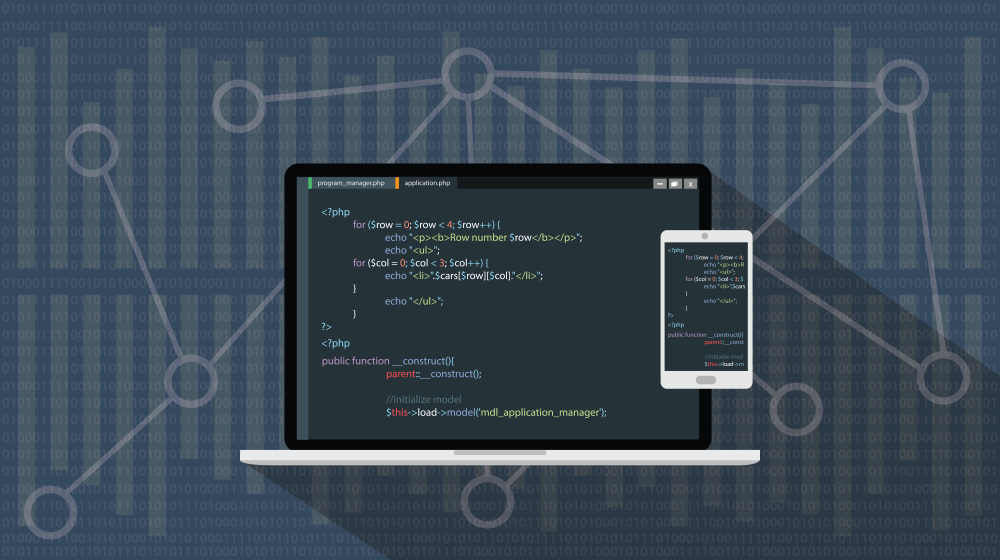
Learn from your fellow PHP developers with our PHP blogs, or help share the knowledge you've gained by writing your own.

CREATE TABLE IF NOT EXISTS <code>subscribers</code> (
<code>id</code> int(11) NOT NULL,
<code>name</code> varchar(255) NOT NULL,
<code>email</code> varchar(255) NOT NULL,
<code>createdAt</code> timestamp NOT NULL DEFAULT CURRENT_TIMESTAMP
) ENGINE=InnoDB DEFAULT CHARSET=latin1;
ALTER TABLE <code>subscribers</code> ADD PRIMARY KEY (<code>id</code>);
ALTER TABLE <code>subscribers</code> MODIFY <code>id</code> int(11) NOT NULL AUTO_INCREMENT;
CREATE TABLE IF NOT EXISTS <code>notifications</code> (
<code>id</code> int(11) NOT NULL,
<code>to_user</code> int(11) NOT NULL,
<code>title</code> varchar(255) NOT NULL,
<code>body</code> varchar(255) NOT NULL,
<code>url</code> varchar(255) NOT NULL,
<code>is_sent</code> int(11) NOT NULL DEFAULT '0',
<code>createdAt</code> timestamp NOT NULL DEFAULT CURRENT_TIMESTAMP
) ENGINE=InnoDB DEFAULT CHARSET=latin1;
ALTER TABLE <code>notifications</code> ADD PRIMARY KEY (<code>id</code>);
ALTER TABLE <code>notifications</code> MODIFY <code>id</code> int(11) NOT NULL AUTO_INCREMENT;
<?php
session_start();
$servername = "localhost";
$username = "root";
$password = "";
$dbname = "web_notifications";
$conn = new mysqli($servername, $username, $password, $dbname);
if ($conn->connect_error) {
die("Connection failed: " . $conn->connect_error);
}
?>
function WriteCookie(key,content) {
var now = new Date();
now.setMonth( now.getMonth() + 1 );
document.cookie = key+"=" + escape(content) + ";";
document.cookie = "expires=" + now.toUTCString() + ";"
}
function ReadCookie(key) {
var allcookies = document.cookie;
cookiearray = allcookies.split(';');
var CookieData=Array();
for(var i=0; i<cookiearray.length; i++) {
k = cookiearray[i].split('=')[0];
v = cookiearray[i].split('=')[1];
CookieData[k]=v;
}
return CookieData[key];
}
<?php require 'db_connect.php';
$sql = "SELECT id,title,body,url FROM notifications where to_user='".@$_GET['user_id']."' and is_sent='0' ";
$result = $conn->query($sql);
$data=array();
if ($result->num_rows > 0) {
while($row = $result->fetch_assoc()) {
$data[]=$row;
$upd = "update notifications set is_sent='1' where id='".$row['id']."' ";
$conn->query($upd);
}
}
if(count($data)>0)
{
$response=array("status"=>1,"notification"=>$data);
}
else
{
$response=array("status"=>0,"error"=>"No new notification!");
}
echo json_encode($response);
$conn->close();
?>
<?php require 'db_connect.php'; ?>
<!DOCTYPE html>
<html>
<head>
<title>Web Push Notification Demo</title>
<script src="./cookies.js" type="text/javascript"></script>
<link href="
<script src="
<script src="
<link rel="stylesheet" href="https://use.fontawesome.com/releases/v5.1.0/css/all.css" integrity="sha384-lKuwvrZot6UHsBSfcMvOkWwlCMgc0TaWr+30HWe3a4ltaBwTZhyTEggF5tJv8tbt" crossorigin="anonymous">
<?php
if(isset($_POST['subscribe_form']))
{
$_SESSION['is_login']=0;
$username=$conn->real_escape_string($_POST['username']);
$useremail=$conn->real_escape_string($_POST['useremail']);
$sql = "INSERT INTO subscribers set name='".$username."',email='".$useremail."' ";
if ($conn->query($sql) === TRUE) {
$_SESSION['is_login']=1;
$_SESSION['Uid']= $conn->insert_id;
$_SESSION['Uname']= $username;
?>
<script type="text/javascript">
WriteCookie("Uid","<?php echo $_SESSION['Uid']; ?>");
</script>
<?php
$msg="<p style='color:green'>You have subscribe for push notification succesfully :)</p>";
} else {
$msg="<p style='color:red'>Error in subscribing for notifications</p>";
}
}
?>
<div class="container">
<?php
if(isset($msg) && $msg!='')
{
?>
<br>
<div class="alert alert-info">
<?php echo $msg; ?>
</div>
<?php
}
if(isset($_SESSION['is_login']) && $_SESSION['is_login']==1)
{
?>
<h2>Welcome <?php echo $_SESSION['Uname']; ?></h2>
<script type="text/javascript">
setInterval(function(){
check_notification();
}, 10000);
function check_notification()
{
var Uid=ReadCookie("Uid");
if(Uid!==undefined)
{
$.ajax({url: "fetch_notifications.php?user_id="+Uid, success: function(result){
var response=JSON.parse(result);
if(response.status==1)
{
response=response.notifications;
for (var i = response.length - 1; i >= 0; i--) {
var url = response[i]['url'];
var noti = new Notification(response[i]['title'], {
icon: 'logo.png', body: response[i]['body'],
});
noti.onclick = function () {
window.open(url);
noti.close();
};
};
}
else{
console.log(response.error);
}
}
});
}
}
</script>
<?php
}
else
{
?>
<h2 class="text-center">Subscribe for Notifications</h2>
<div class="row justify-content-center">
<div class="col-12 col-md-8 col-lg-6 pb-5">
<div class="card border-primary rounded-0">
<div class="card-header p-0">
<div class="bg-info text-white text-center py-2">
<h3><i class="fa fa-envelope"></i> Information</h3>
<p class="m-0">provide your information</p>
</div>
</div>
<div class="card-body p-3">
<form method="post">
<!--Body-->
<div class="form-group">
<div class="input-group mb-2">
<div class="input-group-prepend">
<div class="input-group-text"><i class="fa fa-user text-info"></i></div>
</div>
<input type="text" class="form-control" id="username" name="username" placeholder="Input Your Name Here" required>
</div>
</div>
<div class="form-group">
<div class="input-group mb-2">
<div class="input-group-prepend">
<div class="input-group-text"><i class="fa fa-envelope text-info"></i></div>
</div>
<input type="text" class="form-control" id="useremail" name="useremail" pattern="[^@\s]+@[^@\s]+\.[^@\s]+" title="Invalid email address" placeholder="[email protected]" required>
</div>
</div>
<div class="text-center">
<input type="submit" value="Subscribe" name="subscribe_form" class="btn btn-info btn-block rounded-0 py-2">
</div>
</form>
</div>
</div>
</div>
</div>
<?php }?>
</div>
</head>
<body>
</body>
</html>
<?php
$conn->close();
?>

CREATE TABLE IF NOT EXISTS <code>admin</code> (
<code>id</code> int(11) NOT NULL,
<code>username</code> varchar(255) NOT NULL,
<code>password</code> varchar(255) NOT NULL,
<code>createdAt</code> timestamp NOT NULL DEFAULT CURRENT_TIMESTAMP
) ENGINE=InnoDB DEFAULT CHARSET=latin1;
ALTER TABLE <code>admin</code> ADD PRIMARY KEY (<code>id</code>);
ALTER TABLE <code>admin</code> MODIFY <code>id</code> int(11) NOT NULL AUTO_INCREMENT;
INSERT INTO <code>web_notifications</code>.<code>admin</code> (<code>id</code>, <code>username</code>, <code>password</code>, <code>createdAt</code>) VALUES (NULL, 'admin', MD5('123456'), CURRENT_TIMESTAMP);
<?php require 'db_connect.php'; ?>
<!DOCTYPE html>
<html>
<head>
<title>ADMIN PAGE</title>
<link href="
<script src="
<script src="
<link rel="stylesheet" href="https://use.fontawesome.com/releases/v5.1.0/css/all.css" integrity="sha384-lKuwvrZot6UHsBSfcMvOkWwlCMgc0TaWr+30HWe3a4ltaBwTZhyTEggF5tJv8tbt" crossorigin="anonymous">
<?php
if(isset($_POST['login']))
{
$_SESSION['admin_login']=0;
$username=$conn->real_escape_string($_POST['username']);
$password=$conn->real_escape_string($_POST['password']);
$sql = "SELECT * FROM admin where username='".$username."' and password='".md5($password)."' ";
$result = $conn->query($sql);
if ($result->num_rows > 0) {
$_SESSION['admin_login']=1;
$msg="<p style='color:green'>Admin Logged-in Successfully :)</p>";
}
else {
$msg="<p style='color:red'>INVALID CREDENTIALS FOR ADMIN</p>";
}
}
if(isset($_POST['add_notification']))
{
$title=$conn->real_escape_string($_POST['title']);
$body=$conn->real_escape_string($_POST['body']);
$url=$conn->real_escape_string($_POST['url']);
$users=$_POST['users'];
foreach ($users as $user_id) {
$ins = "insert into notifications set to_user='".$user_id."' , title='".$title."', url='".$url."', body='".$body."' ";
$conn->query($ins);
}
$msg="<p style='color:green'>Notification(s) added to subscribers account.</p>";
}
?>
<div class="container">
<?php
if(isset($msg) && $msg!='')
{
?>
<br>
<div class="alert alert-info">
<?php echo $msg; ?>
</div>
<?php
}
if(isset($_SESSION['admin_login']) && $_SESSION['admin_login']==1)
{
?>
<h2>Welcome Admin, Send notification to Subscriber(s)</h2>
<form method="post">
<div class="form-group">
<label for="sel1">Select Subscriber(s):</label>
<select multiple="multiple" required="required" class="form-control" id="users" name="users[]">
<?php
$sql = "SELECT id,name FROM subscribers";
$result = $conn->query($sql);
$data=array();
if ($result->num_rows > 0) {
while($row = $result->fetch_assoc()) {
echo "<option value='".$row['id']."'>".$row['name']."</option>";
}
}
?>
</select>
</div>
<div class="form-group">
<label for="email">Title</label>
<input type="text" required class="form-control" placeholder="notification title here" name="title" id="title">
</div>
<div class="form-group">
<label for="email">Message</label>
<textarea required class="form-control" placeholder="notification message here" name="body" id="body"></textarea>
</div>
<div class="form-group">
<label for="email">Url</label>
<input type="url" required class="form-control" placeholder="notification landing/click url here" name="url" id="url">
</div>
<input type="submit" class="btn btn-primary btn-block" name="add_notification" value="Submit" />
</form>
<?php
}
else
{
?>
<h2 class="text-center">ADMINISTRATOR</h2>
<div class="row justify-content-center">
<div class="col-12 col-md-8 col-lg-6 pb-5">
<div class="card border-primary rounded-0">
<div class="card-header p-0">
<div class="bg-info text-white text-center py-2">
<h3><i class="fa fa-envelope"></i> LOGIN</h3>
<p class="m-0">provide admin login credentials</p>
</div>
</div>
<div class="card-body p-3">
<form method="post">
<!--Body-->
<div class="form-group">
<div class="input-group mb-2">
<div class="input-group-prepend">
<div class="input-group-text"><i class="fa fa-user text-info"></i></div>
</div>
<input type="text" class="form-control" id="username" name="username" placeholder="Input username here" required>
</div>
</div>
<div class="form-group">
<div class="input-group mb-2">
<div class="input-group-prepend">
<div class="input-group-text"><i class="fa fa-key text-info"></i></div>
</div>
<input type="password" class="form-control" id="password" name="password" placeholder="your password here" required>
</div>
</div>
<div class="text-center">
<input type="submit" value="Login" name="login" class="btn btn-info btn-block rounded-0 py-2">
</div>
</form>
</div>
</div>
</div>
</div>
<?php }?>
</div>
</head>
<body>
</body>
</html>
<?php
$conn->close();
?>


$student = student::join(‘marks’,’marks.student_id,’=’,students.id’)->where(‘students.id’,’1’)->get();
dd($student);
$student_marks = student::find(1);
dd($student_marks->mark1);
hasone() and belongsto().Schema::create('users', function (Blueprint $table) {
$table->increments('id');
$table->string('name');
$table->string('email')->unique();
$table->string('password');
$table->rememberToken();
$table->timestamps();
});
Schema::create('phones', function (Blueprint $table) {
$table->increments('id');
$table->integer('user_id')->unsigned();
$table->string('phone');
$table->timestamps();
$table->foreign('user_id')->references('id')->on('users')
->onDelete('cascade');
});
<?php
namespace App;
use Illuminate\Notifications\Notifiable;
use Illuminate\Foundation\Auth\User as Authenticatable;
class User extends Authenticatable
{
use Notifiable;
protected $fillable = [
'name', 'email', 'password',
];
protected $hidden = [
'password', 'remember_token',
];
public function phone()
{
return $this->hasOne('App\Phone');
}
}
<?php
namespace App;
use Illuminate\Database\Eloquent\Model;
class Phone extends Model
{
public function user()
{
return $this->belongsTo('App\User');
}
}
$user = User::find(1);
$phone = new Phone;
$phone->phone = '9080054945';
$user->phone()->save($phone);
$phone = Phone::find(1);
$user = User::find(10);
$phone->user()->associate($user)->save();
$phone = User::find(1)->phone;
dd($phone);
$user = Phone::find(1)->user;
dd($user);
hasMany() and belongsTo() for relationshipsSchema::create('posts', function (Blueprint $table) {
$table->increments('id');
$table->string("name");
$table->timestamps();
});
Schema::create('comments', function (Blueprint $table) {
$table->increments('id');
$table->integer('post_id')->unsigned();
$table->string("comment");
$table->timestamps();
$table->foreign('post_id')->references('id')->on('posts')
->onDelete('cascade');
});
<?php
namespace App;
use Illuminate\Database\Eloquent\Model;
class Post extends Model
{
public function comments()
{
return $this->hasMany(Comment::class);
}
}
<?php
namespace App;
use Illuminate\Database\Eloquent\Model;
class Comment extends Model
{
public function post()
{
return $this->belongsTo(Post::class);
}
}
$post = Post::find(1);
$comment = new Comment;
$comment->comment = "Hi Harikrishnan";
$post = $post->comments()->save($comment);
$post = Post::find(1);
$comment1 = new Comment;
$comment1->comment = "How are You?";
$comment2 = new Comment;
$comment2->comment = "Where are you?";
$post = $post->comments()->saveMany([$comment1, $comment2]);
$comment = Comment::find(1);
$post = Post::find(2);
$comment->post()->associate($post)->save();
$post = Post::find(1);
$comments = $post->comments;
dd($comments);
$comment = Comment::find(1);
$post = $comment->post;
dd($post);
belongsToMany() we will use see a demo of Many to many relationshipSchema::create('users', function (Blueprint $table) {
$table->increments('id');
$table->string('name');
$table->string('email')->unique();
$table->string('password');
$table->rememberToken();
$table->timestamps();
});
Schema::create('roles', function (Blueprint $table) {
$table->increments('id');
$table->string('name');
$table->timestamps();
});
Schema::create('role_user', function (Blueprint $table) {
$table->integer('user_id')->unsigned();
$table->integer('role_id')->unsigned();
$table->foreign('user_id')->references('id')->on('users')
->onDelete('cascade');
$table->foreign('role_id')->references('id')->on('roles')
->onDelete('cascade');
});
<?php
namespace App;
use Illuminate\Notifications\Notifiable;
use Illuminate\Foundation\Auth\User as Authenticatable;
class User extends Authenticatable
{
use Notifiable;
protected $fillable = [
'name', 'email', 'password',
];
protected $hidden = [
'password', 'remember_token',
];
public function roles()
{
return $this->belongsToMany(Role::class, 'role_user');
}
}
<?php
namespace App;
use Illuminate\Database\Eloquent\Model;
class Role extends Model
{
public function users()
{
return $this->belongsToMany(User::class, 'role_user');
}
}
<?php
namespace App;
use Illuminate\Database\Eloquent\Model;
class UserRole extends Model
{
}
$user = User::find(2);
$roleIds = [1, 2];
$user->roles()->attach($roleIds);
$user = User::find(3);
$roleIds = [1, 2];
$user->roles()->sync($roleIds);
$role = Role::find(1);
$userIds = [10, 11];
$role->users()->attach($userIds);
$role = Role::find(2);
$userIds = [10, 11];
$role->users()->sync($userIds);
$user = User::find(1);
dd($user->roles);
$role = Role::find(1);
dd($role->users);

<?php
namespace App;
use App\Comment;
use App\CommentVote;
use App\CommentSpam;
use App\User;
use Auth;
class CommentModel
{
}
?>
public function getAllComments($pageId)
{
$comments = Comment::where('page_id',$pageId)->get();
$commentsData = [];
foreach ($comments as $key) {
$user = User::find($key->users_id);
$name = $user->name;
$replies = $this->replies($key->id);
$photo = $user->first()->photo_url;
$reply = 0;
$vote = 0;
$voteStatus = 0;
$spam = 0;
if(Auth::user()){
$voteByUser = CommentVote::where('comment_id',$key->id)->where('user_id',Auth::user()->id)->first();
$spamComment = CommentSpam::where('comment_id',$key->id)->where('user_id',Auth::user()->id)->first();
if($voteByUser){
$vote = 1;
$voteStatus = $voteByUser->vote;
}
if($spamComment){
$spam = 1;
}
}
if(sizeof($replies) > 0){
$reply = 1;
}
if(!$spam){
array_push($commentsData,[
"name" => $name,
"photo_url" => (string)$photo,
"commentid" => $key->id,
"comment" => $key->comment,
"votes" => $key->votes,
"reply" => $reply,
"votedByUser" =>$vote,
"vote" =>$voteStatus,
"spam" => $spam,
"replies" => $replies,
"date" => $key->created_at->toDateTimeString()
]);
}
}
$collection = collect($commentsData);
return $collection->sortBy('votes');
}
protected function replies($commentId)
{
$comments = Comment::where('reply_id',$commentId)->get();
$replies = [];
foreach ($comments as $key) {
$user = User::find($key->users_id);
$name = $user->name;
$photo = $user->first()->photo_url;
$vote = 0;
$voteStatus = 0;
$spam = 0;
if(Auth::user()){
$voteByUser = CommentVote::where('comment_id',$key->id)->where('user_id',Auth::user()->id)->first();
$spamComment = CommentSpam::where('comment_id',$key->id)->where('user_id',Auth::user()->id)->first();
if($voteByUser){
$vote = 1;
$voteStatus = $voteByUser->vote;
}
if($spamComment){
$spam = 1;
}
}
if(!$spam){
array_push($replies,[
"name" => $name,
"photo_url" => $photo,
"commentid" => $key->id,
"comment" => $key->comment,
"votes" => $key->votes,
"votedByUser" => $vote,
"vote" => $voteStatus,
"spam" => $spam,
"date" => $key->created_at->toDateTimeString()
]);
}
}
$collection = collect($replies);
return $collection->sortBy('votes');
}
public function createComment($arary)
{
$comment = Comment::create($array);
if($comment)
return [ "status" => "true","commentId" => $comment->id ];
else
return [ "status" => "false" ];
}
<?php
namespace App;
use App\Comment;
use App\CommentSpam;
use App\CommentVote;
use App\User;
use Auth;
class CommentModel
{
public function getAllComments($pageId)
{
$comments = Comment::where('page_id', $pageId)->get();
$commentsData = [];
foreach ($comments as $key) {
$user = User::find($key->users_id);
$name = $user->name;
$replies = $this->replies($key->id);
$photo = $user->first()->photo_url;
$reply = 0;
$vote = 0;
$voteStatus = 0;
$spam = 0;
if (Auth::user()) {
$voteByUser = CommentVote::where('comment_id', $key->id)->where('user_id', Auth::user()->id)->first();
$spamComment = CommentSpam::where('comment_id', $key->id)->where('user_id', Auth::user()->id)->first();
if ($voteByUser) {
$vote = 1;
$voteStatus = $voteByUser->vote;
}
if ($spamComment) {
$spam = 1;
}
}
if (sizeof($replies) > 0) {
$reply = 1;
}
if (!$spam) {
array_push($commentsData, [
"name" => $name,
"photo_url" => (string) $photo,
"commentid" => $key->id,
"comment" => $key->comment,
"votes" => $key->votes,
"reply" => $reply,
"votedByUser" => $vote,
"vote" => $voteStatus,
"spam" => $spam,
"replies" => $replies,
"date" => $key->created_at->toDateTimeString(),
]);
}
}
$collection = collect($commentsData);
return $collection->sortBy('votes');
}
protected function replies($commentId)
{
$comments = Comment::where('reply_id', $commentId)->get();
$replies = [];
foreach ($comments as $key) {
$user = User::find($key->users_id);
$name = $user->name;
$photo = $user->first()->photo_url;
$vote = 0;
$voteStatus = 0;
$spam = 0;
if (Auth::user()) {
$voteByUser = CommentVote::where('comment_id', $key->id)->where('user_id', Auth::user()->id)->first();
$spamComment = CommentSpam::where('comment_id', $key->id)->where('user_id', Auth::user()->id)->first();
if ($voteByUser) {
$vote = 1;
$voteStatus = $voteByUser->vote;
}
if ($spamComment) {
$spam = 1;
}
}
if (!$spam) {
array_push($replies, [
"name" => $name,
"photo_url" => $photo,
"commentid" => $key->id,
"comment" => $key->comment,
"votes" => $key->votes,
"votedByUser" => $vote,
"vote" => $voteStatus,
"spam" => $spam,
"date" => $key->created_at->toDateTimeString(),
]);
}
}
$collection = collect($replies);
return $collection->sortBy('votes');
}
public function createComment($arary)
{
$comment = Comment::create($array);
if ($comment) {
return ["status" => "true", "commentId" => $comment->id];
} else {
return ["status" => "false"];
}
}
public function voteComment($commentId, $array)
{
$comments = Comment::find($commentId);
$data = [
"comment_id" => $commentId,
'vote' => $array->vote,
'user_id' => $array->users_id,
];
if ($array->vote == "up") {
$comment = $comments->first();
$vote = $comment->votes;
$vote++;
$comments->votes = $vote;
$comments->save();
}
if ($array->vote == "down") {
$comment = $comments->first();
$vote = $comment->votes;
$vote--;
$comments->votes = $vote;
$comments->save();
}
if (CommentVote::create($data)) {
return true;
}
}
public function spamComment($commentId, $array)
{
$comments = Comment::find($commentId);
$comment = $comments->first();
$spam = $comment->spam;
$spam++;
$comments->spam = $spam;
$comments->save();
$data = [
"comment_id" => $commentId,
'user_id' => $array->users_id,
];
if (CommentSpam::create($data)) {
return true;
}
}
}
?>
<?php
namespace App\Http\Controllers;
use Illuminate\Http\Request;
use App\Http\Requests;
use App\Comment;
use App\CommentVote;
use App\CommentSpam;
use App\User;
use Auth;
class CommentController extends Controller
{
public function index($pageId)
{
$comments = Comment::where('page_id',$pageId)->get();
$commentsData = [];
foreach ($comments as $key) {
$user = User::find($key->users_id);
$name = $user->name;
$replies = $this->replies($key->id);
$photo = $user->first()->photo_url;
$reply = 0;
$vote = 0;
$voteStatus = 0;
$spam = 0;
if(Auth::user()){
$voteByUser = CommentVote::where('comment_id',$key->id)->where('user_id',Auth::user()->id)->first();
$spamComment = CommentSpam::where('comment_id',$key->id)->where('user_id',Auth::user()->id)->first();
if($voteByUser){
$vote = 1;
$voteStatus = $voteByUser->vote;
}
if($spamComment){
$spam = 1;
}
}
if(sizeof($replies) > 0){
$reply = 1;
}
if(!$spam){
array_push($commentsData,[
"name" => $name,
"photo_url" => (string)$photo,
"commentid" => $key->id,
"comment" => $key->comment,
"votes" => $key->votes,
"reply" => $reply,
"votedByUser" =>$vote,
"vote" =>$voteStatus,
"spam" => $spam,
"replies" => $replies,
"date" => $key->created_at->toDateTimeString()
]);
}
}
$collection = collect($commentsData);
return $collection->sortBy('votes');
}
protected function replies($commentId)
{
$comments = Comment::where('reply_id',$commentId)->get();
$replies = [];
foreach ($comments as $key) {
$user = User::find($key->users_id);
$name = $user->name;
$photo = $user->first()->photo_url;
$vote = 0;
$voteStatus = 0;
$spam = 0;
if(Auth::user()){
$voteByUser = CommentVote::where('comment_id',$key->id)->where('user_id',Auth::user()->id)->first();
$spamComment = CommentSpam::where('comment_id',$key->id)->where('user_id',Auth::user()->id)->first();
if($voteByUser){
$vote = 1;
$voteStatus = $voteByUser->vote;
}
if($spamComment){
$spam = 1;
}
}
if(!$spam){
array_push($replies,[
"name" => $name,
"photo_url" => $photo,
"commentid" => $key->id,
"comment" => $key->comment,
"votes" => $key->votes,
"votedByUser" => $vote,
"vote" => $voteStatus,
"spam" => $spam,
"date" => $key->created_at->toDateTimeString()
]);
}
}
$collection = collect($replies);
return $collection->sortBy('votes');
}
public function store(Request $request)
{
$this->validate($request, [
'comment' => 'required',
'reply_id' => 'filled',
'page_id' => 'filled',
'users_id' => 'required',
]);
$comment = Comment::create($request->all());
if($comment)
return [ "status" => "true","commentId" => $comment->id ];
}
public function update(Request $request, $commentId,$type)
{
if($type == "vote"){
$this->validate($request, [
'vote' => 'required',
'users_id' => 'required',
]);
$comments = Comment::find($commentId);
$data = [
"comment_id" => $commentId,
'vote' => $request->vote,
'user_id' => $request->users_id,
];
if($request->vote == "up"){
$comment = $comments->first();
$vote = $comment->votes;
$vote++;
$comments->votes = $vote;
$comments->save();
}
if($request->vote == "down"){
$comment = $comments->first();
$vote = $comment->votes;
$vote--;
$comments->votes = $vote;
$comments->save();
}
if(CommentVote::create($data))
return "true";
}
if($type == "spam"){
$this->validate($request, [
'users_id' => 'required',
]);
$comments = Comment::find($commentId);
$comment = $comments->first();
$spam = $comment->spam;
$spam++;
$comments->spam = $spam;
$comments->save();
$data = [
"comment_id" => $commentId,
'user_id' => $request->users_id,
];
if(CommentSpam::create($data))
return "true";
}
}
public function destroy($id)
{
}
}?>
<?php
namespace App\Http\Controllers;
use App\CommentModel;
use Illuminate\Http\Request;
class CommentController extends Controller
{
private $commentModel = null;
private function __construct()
{
$this->commentModel = new CommentModel();
}
public function index($pageId)
{
return $this->commentModel->getAllComments($pageId);
}
public function store(Request $request)
{
$this->validate($request, [
'comment' => 'required',
'reply_id' => 'filled',
'page_id' => 'filled',
'users_id' => 'required',
]);
return $this->commentModel->createComment($request->all());
}
public function update(Request $request, $commentId, $type)
{
if ($type == "vote") {
$this->validate($request, [
'vote' => 'required',
'users_id' => 'required',
]);
return $this->commentModel->voteComment($commentId, $request->all());
}
if ($type == "spam") {
$this->validate($request, [
'users_id' => 'required',
]);
return $this->commentModel->spamComment($commentId, $request->all());
}
}
}
?>

umask(0);
$pid = pcntl_fork();
if ($pid < 0) {
print('fork failed');
exit 1;
}
if ($pid > 0) { echo "daemon process started
";
exit;
}
$sid = posix_setsid();
if ($sid < 0) {
exit 2;
}
chdir('/');
file_put_contents($pidFilename, getmypid() );
run_process();ob_start();
var_dump($some_object);
$content = ob_get_clean();
fwrite($fd_log, $content); ini_set('error_log', $logDir.'/error.log');
fclose(STDIN);
fclose(STDOUT);
fclose(STDERR);
$STDIN = fopen('/dev/null', 'r');
$STDOUT = fopen($logDir.'/application.log', 'ab');
$STDERR = fopen($logDir.'/application.error.log', 'ab');
function sig_handler($signo)
{
global $fd_log;
switch ($signo) {
case SIGTERM:
fclose($fd_log); unlink($pidfile); exit;
break;
case SIGHUP:
init_data(); break;
default:
}
}
pcntl_signal(SIGTERM, "sig_handler");
pcntl_signal(SIGHUP, "sig_handler");
$base = event_base_new();
$event = event_new();
$errno = 0;
$errstr = '';
$socket = stream_socket_server("tcp://$IP:$port", $errno, $errstr);
stream_set_blocking($socket, 0);
event_set($event, $socket, EV_READ | EV_PERSIST, 'onAccept', $base);
function onRead($buffer, $id)
{
while($read = event_buffer_read($buffer, 256)) {
var_dump($read);
}
}
function onError($buffer, $error, $id)
{
global $id, $buffers, $ctx_connections;
event_buffer_disable($buffers[$id], EV_READ | EV_WRITE);
event_buffer_free($buffers[$id]);
fclose($ctx_connections[$id]);
unset($buffers[$id], $ctx_connections[$id]);
}
$event2 = event_new();
$tmpfile = tmpfile();
event_set($event2, $tmpfile, 0, 'onTimer', $interval);
$res = event_base_set($event2, $base);
event_add($event2, 1000000 * $interval);
function onTimer($tmpfile, $flag, $interval)
{
$global $base, $event2;
if ($event2) {
event_delete($event2);
event_free($event2);
}
call_user_function(‘process_data’,$args);
$event2 = event_new();
event_set($event2, $tmpfile, 0, 'onTimer', $interval);
$res = event_base_set($event2, $base);
event_add($event2, 1000000 * $interval);
}
event_delete($event);
event_free($event);
event_base_free($base);
event_base_set($event, $base);
event_add($event);
function onAccept($socket, $flag, $base) {
global $id, $buffers, $ctx_connections;
$id++;
$connection = stream_socket_accept($socket);
stream_set_blocking($connection, 0);
$buffer = event_buffer_new($connection, 'onRead', NULL, 'onError', $id);
event_buffer_base_set($buffer, $base);
event_buffer_timeout_set($buffer, 30, 30);
event_buffer_watermark_set($buffer, EV_READ, 0, 0xffffff); event_buffer_priority_set($buffer, 10); event_buffer_enable($buffer, EV_READ | EV_PERSIST); $ctx_connections[$id] = $connection;
$buffers[$id] = $buffer;
}
#! /bin/sh
#
$appdir = /usr/share/myapp/app.php
$parms = --master –proc=8 --daemon
export $appdir
export $parms
if [ ! -x appdir ]; then
exit 1
fi
if [ -x /etc/rc.d/init.d/functions ]; then
. /etc/rc.d/init.d/functions
fi
RETVAL=0
start () {
echo "Starting app"
daemon /usr/bin/php $appdir $parms
RETVAL=$?
[ $RETVAL -eq 0 ] && touch /var/lock/subsys/mydaemon
echo
return $RETVAL
}
stop () {
echo -n "Stopping $prog: "
killproc /usr/bin/fetchmail
RETVAL=$?
[ $RETVAL -eq 0 ] && rm -f /var/lock/subsys/mydaemon
echo
return $RETVAL
}
case in
start)
start
;;
stop)
stop
;;
restart)
stop
start
;;
status)
status /usr/bin/mydaemon
;;
*)
echo "Usage: {start|stop|restart|status}"
;;
RETVAL=$?
exit $RETVAL
#php app.phar
myDaemon version 0.1 Debug
usage:
--daemon – run as daemon
--debug – run in debug mode
--settings – print settings
--nofork – not run child processes
--check – check dependency modules
--master – run as master
--proc=[8] – run child processes






 mike
mike crocodile2u
crocodile2u MindNovae
MindNovae tanja
tanja damnjan
damnjan
